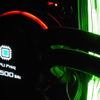19. Final words & conclusion
Conclusion
These LCS kits performed very well and can quite easily handle an overclocked Core i7 8700K processor at 4.8 GHz (we do use a delidded one). With RGB support also provided for the pump enclosure, we feel that this series will find many buyers. The prices are higher than what the competition offers, but you must remember that these coolers offer more. The radiators are perhaps a little plain?, but the pump block part is really interesting, and it should be the main selling point, especially with the 1.77” OLED display that is highly customizable. The OLED screen can be very useful when set to display temperature, voltage, or frequency or just a decoration if it displays a logo or various animations with text. Even Threadripper CPUs are supported with the provided bracket (and of course other modern AMD and Intel processors as well). Pricing, however, well that remains a bit of a debate, ROG products are increasingly gett expensive.
The RGB in Asus’s AIOs really makes a very positive impression. The quality braided tubes bend well, and they can be adjusted in many ways to avoid compatibility issues. Installation is not time-consuming, and it’s straightforward, so users shouldn’t have any problems with the process. The manual could be a bit better with regard to a couple of the installation steps, but that’s nothing that you couldn’t manage as it is. There’s also an issue with temperature readings in the Asus AI Suite (about 15 degrees lower than in HW Monitor), which can create problems with fan control, resulting in a delayed RPM increase response. The included fans are of good quality, but they could have been less noisy for the Ryuo 240. The Ryujin’s Noctuas are noticeably better. The VRM cooling fan is a good and effective idea, but it makes sense to lower the RPMs for it, as the default revs are too high.
As for the wiring stuff, it looks a bit like wire spaghetti at first glance, but it was relatively easy to manage it and to avoid a mess. Summing it all up – the Asus AIOs are high-quality kits with above-average performance (the Ryuo gets a bit loud under load) that are easy to assemble and very pleasing to look at, with an OLED display that makes them stand out from the crowd. Even though there are some minor drawbacks (which can and should be corrected) the reviewed kits from ROG deserve a prize. “Top pick” for Ryujin Series and “Recommended” for Ryuo 240.
Top Pick award: ROG Ryujin 240/360
Recommended award: ROG Ryuo 240
Handy related downloads:
- Sign up to receive a notice when we publish a new article
- Or go back to Guru3D's front page.



